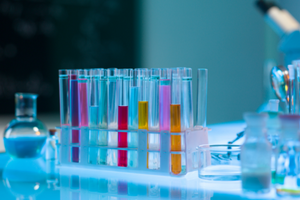Acids form another large group of non-organic compounds aside from hydroxides or salts. They are present in the lives of all of us. We can find them, for instance, in mammals’ gastric juice, preservatives or additives designed for improving the taste of food products. They also constitute an important component in chemical industry processes.

Structure and properties of acids
In principle, acids consist of hydrogen atoms and an acid radical. Based on the type of acid radical, we classify these compounds into oxyacids and hydracids. Oxyacids are the acids whose radical includes the atom(s) of oxygen. It is not contained in hydracids. To learn more about the former group, read our article on oxyacids.
Acids can also be divided into single-proton acids (whose molecule contains one hydrogen atom) and multi-proton acids (which have more than one hydrogen atom). Please note that the multi-proton acids undergo gradual electrolytic dissociation in aqueous solutions. This process leads to the production of acid salts.
As already indicated, the structure of hydracids includes no atoms of oxygen. The simplest of these compounds combine the atoms of hydrogen and a non-metal. When building an appropriate molecular formula, we should include the valence of the hydrogen atom but also that of the acid radical.
How to create the names of acids? The element that goes first is the acid radical, which is followed by the word ‘acid’, for example:
- Hydrochloric acid, HCl;
- Hydrosulphuric acid, H2S;
- Hydrobromic acid, HBr, etc.
Acids in aqueous solutions undergo electrolytic dissociation, meaning they decompose into ions: hydrogen cations and acid radical anions. This makes them capable of conveying electric charges in a solution, that is, conducting current.
In aqueous solutions, they show an acidic reaction which is caused by the presence of hydrogen ions. Their content can be determined, for instance, by measuring the pH or estimating visually with indicator papers which change colour depending on the solution’s pH value (it will be red for a strong acid, or orange if the acid is weak).
The production of hydracids consists in dissolving an appropriate gas in water. To give an example, the water absorption of hydrogen chloride (a gaseous substance) produces hydrochloric acid. Therefore, the most important hydracids are the aqueous solutions of relevant hydrides. Hydrides, in turn, are obtained by direct synthesis from elements or by separation from salts, which are affected by a strong acid. The water solubility of these gases is relatively high, which allows us to obtain high-concentration acids.
Hydrochloric acid
The most commonly used hydracid is the hydrochloric acid (HCl). Its radical is an ion of chlorine. Hydrochloric acid is a colourless liquid whose density is higher than that of water. It is highly irritating. Its concentrated solution (commercially available at a concentration of up to 38%) generates characteristic white fumes. These are droplets of hydrochloric acid – the gaseous hydrogen chloride escaping the vessel bonds with the airborne steam and is visible as a ‘white fume’. In contact with a fabric, skin or paper, hydrochloric acid will destroy them. Any work that involves the use of this compound must be carried out with safety goggles, protective clothing and gloves. Heightened caution is absolutely necessary, as a burn caused by hydrochloric acid is very dangerous.
In laboratory conditions and on an industrial scale, hydrochloric acid can be obtained by dissolving gaseous hydrogen chloride in water. The industrial acquisition of this compound often goes along with other chemical processes, for example where hydrogen chloride is derived as a by-product. Significant amounts of hydrochloric acid are generated by electrolysing the aqueous solution of sodium chloride. The by-products (chlorine and hydrogen) react with each other and, as gaseous HCl, can then be absorbed in water.
A diluted hydrochloric acid solution is included in the gastric juice of humans and other mammals. It plays a number of significant roles in digestion processes. Hydrochloric acid is an important component of many industrial processes. For instance, it is applied in metalworking and in textile and sugar industries. The pharmaceutical industry also uses this compound, for example to produce anti-hypochlorhydria formulations. The dyes obtained with the use of hydrochloric acid are contained in certain coloured cosmetics.

Hydrosulphuric acid
Hydrosulphuric acid is another example of a non-organic hydracid, having the molecular formula H2S. Its molecule is made of two atoms of hydrogen and one atom of sulphur. The compound is an aqueous solution of hydrogen sulphide (a gas that is sparingly soluble in water). It has the form of a colourless liquid with a characteristic odour.
Like other hydracids, hydrosulphuric acid is acquired by absorbing hydrogen sulphide in water. That gas is, in turn, produced by direct synthesis from elements or by other reactions where H2S is one of the products. Hydrogen sulphide is a strong poison. It is dangerous even at a low concentration. This is why working with it requires particular caution.
Hydrosulphuric acid is utilised mainly in chemical laboratories. It is used for detecting certain metals. It can serve as a component in medicinal water present in many health resorts as well as depilation formulations.
Other hydracids
Hydracids are a fairly large group of chemical compounds with characteristic properties. The most prominent are obviously the hydrochloric and hydrosulphuric acids, which are used on a daily basis in many industrial sectors and in laboratory practice.
Below we present examples of other hydracids:
- Hydrofluoric acid, HF;
- Hydrobromic acid, HBr;
- Hydroiodic acid, HI;
- Hydroselenic acid, H2Se;
- Hydrocyanic acid, HCN;
- Thiocyanic acid, HSCN.